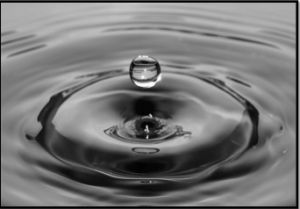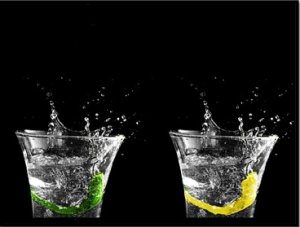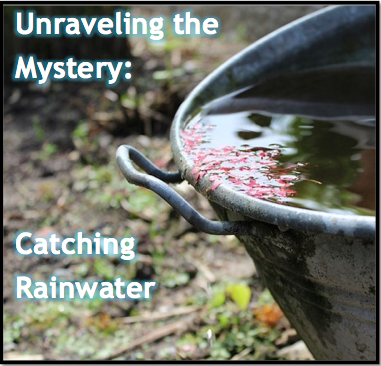Catching rainwater seems pretty straightforward, right? Just set something up for rain to land on and let it drain into a container, right? At its most simple, you would be correct but the full picture is a little more complicated than that. Since you likely intend on consuming the water you catch, you need to consider the filtering and storage, too. Depending on where you live, catching rainwater may even be illegal! I swear I’m not making this up! Read on…
Where I live, we get an average of 154 inches of rain a year. Yeah…it’s wet around here. Our sloppiest year brought us 14 feet! The upside of all that liquid sunshine is that you don’t have to really worry about where your drinking water will come from. Growing up, it was 100% normal to see large water cisterns with pipes that lead from the roof of the house into the water tank. Of course, even here in rural Alaska, laws are being enacted by local authorities against building water catch systems on any new construction but that is a rant for another time. This one is all about the system and things to consider when setting one up.
Assuming you want to catch water and consume it, there are 4 steps to the system:
Catching the Water
I know it seems incredibly simple and honestly, it is but there are many things you have to consider when it comes to catching and funneling rainwater to a drain. First off, is the area where the rain will fall mostly clean? Will it rot, rust, or grow mold? Can you get to it and clean it a couple times a year? Are there lots of trees around that will drop leaves onto the surface, eventually clogging the pipes to the holding tank? That water will have to go somewhere and if you don’t keep your drainage clear, it will go places you really never wanted it to.
 Once you have dealt with the surface, you need to pay attention to the piping (or gutters) that will carry the water into the holding tank. Will they freeze? Can you ensure as little debris as possible will make it into the holding tank? Can animals get into the pipes or the tank? How likely is it for birds or other animals’ feces get into the water? Is everything secure enough to handle high wind storms or long term downpours? Will it back up if the water is flowing too fast?
Once you have dealt with the surface, you need to pay attention to the piping (or gutters) that will carry the water into the holding tank. Will they freeze? Can you ensure as little debris as possible will make it into the holding tank? Can animals get into the pipes or the tank? How likely is it for birds or other animals’ feces get into the water? Is everything secure enough to handle high wind storms or long term downpours? Will it back up if the water is flowing too fast?
Holding the Water
Now that you have a suitable area to catch water (a roof, tarps set up, etc) and the drainage is good, you need to turn your attention to the holding tank. There are numerous ways to hold the water but, as before, there are many things to consider when setting your system up. You aren’t just holding the water, you are storing pre-filtered water. That means there are all sorts of bugs and nasties that can grow in there which can make you sick.
The best first defense is how you catch the water: making sure little to no debris or animal matter get into the tank. The tank itself must be protected so nothing can float down into it on the wind or from trees and buildings above. Around here, most people have the pipes leading from the gutter of their home to the covered tank where it flows inside, protected. I have seen others who have water catch systems at their cabins that has a screen the water flows through before it goes into the holding tank and this is a great way to get larger bits out that could rot.
Will the tank be able to handle hot and cold extremes? Will it rot, rust, or grow mold? What about the weight and pressure of all that water just dying to get out and flow freely? If a pack of wild pre-teens careened into it during a rousing game of tackle football, would it crack? If you have any question about the integrity of your holding tank, get a better one or make do until you can. Personally, if I was setting one up for just the garden, I would choose this tank.
Filtering the Water
So you have your catching area and piping set. Your gutters filter out the obvious debris and maybe then again as it drains into the holding tank. Now comes the part of making it potable.
There are numerous ways to filter your water and I will not go into details of “how you should do it” because I don’t live where you do. I don’t know your situation and if there is anything homesteading has taught me, it’s that there are multiple ways to get to the same destination and just because it is different, doesn’t mean it’s wrong. That being said, if your filtering doesn’t get the nasties out, you are failing and need to head back to the drawing board.
 For us, we have a pressure tank that is hooked up to the electrical system and keeps the tank full. When we turn on the tap, the water is pumped out of the tank and through our filtration system before it gets to me at the sink. Now, living where we do, we have some pristine rain water. It has been tested time and again and truly could be consumed without any filtering but I tend to err on the side of caution because I just don’t enjoy being sick. Call me fickle but the idea of tummy cramps and trips to the bathroom isn’t my idea of a good time. Better safe than sorry! Because the water stays in the tank until we need it, there isn’t much else we need to do. If the power goes out, we can hook up the generator to the pump and have running water again. For everyone’s situation though, this is just not feasible. They need to be able to store it after it has been filtered.
For us, we have a pressure tank that is hooked up to the electrical system and keeps the tank full. When we turn on the tap, the water is pumped out of the tank and through our filtration system before it gets to me at the sink. Now, living where we do, we have some pristine rain water. It has been tested time and again and truly could be consumed without any filtering but I tend to err on the side of caution because I just don’t enjoy being sick. Call me fickle but the idea of tummy cramps and trips to the bathroom isn’t my idea of a good time. Better safe than sorry! Because the water stays in the tank until we need it, there isn’t much else we need to do. If the power goes out, we can hook up the generator to the pump and have running water again. For everyone’s situation though, this is just not feasible. They need to be able to store it after it has been filtered.
***Don’t forget to think about how you will pump water! Unless you are using gravity, you will need to come up with a way to get that water where you want it to be. That can be a hand pump, an electrical system, or you could always use a bucket! 😉
Storing the Water
This will vary for people in different locations but when it comes to storing water, you need to make sure that it will not be in a place where direct sunlight or excessive heat will get to it. Keeping water in 5 gallon plastic jugs in a garage that gets over 100 degrees in the summer is probably not the best idea. You also don’t want to store water where it will freeze and thaw multiple times because no matter how awesome your container is, eventually the water will win and crack it, causing quite the mess.
There are numerous other factors to consider that will be more specific to your area such as rain pollution, local laws, and pesky neighbors. I am not some ‘water expert’ here; just a lady who is used to and comfortable with water catchment systems for not only drinking and washing water but also for the garden, washing the dogs, everything!
Before you dive into making a water catching system, check with your local authorities, HOAs, etc., to ensure it is legal to do so. Even if you don’t need a water catch system, consider making one anyway just in case. It never hurts to have water stored for dry spells in the summer when you need it for the garden or, worse case scenario, a disaster has struck and you need emergency water!
See? There really is a lot more to it than just setting up a gutter and bucket to catch water in. When it comes to your potable drinking water, you cannot be too careful. Your life could depend on this system and now is not the time to cut corners. Your construction doesn’t have to be pretty but it does need to be stout and hardy.





Great article. I enjoyed it.
I am glad! I hope you will pull up a chair and hang out a bit. Lots of info on here. Thanks for the comment!
We use rainwater tanks here, don’t use a filtering system because the water is always being circulated with solar powered water pumps in each tank. Plus we sometimes have to buy water, so it’s already treated.
I have found some interesting reading on this site and it’s definitely going into my favorites.
Thanks for the great ideas and info.
Thank you and welcome! We don’t treat our rainwater here and the filtering helps remove any bird droppings or anything picked up from the roof.